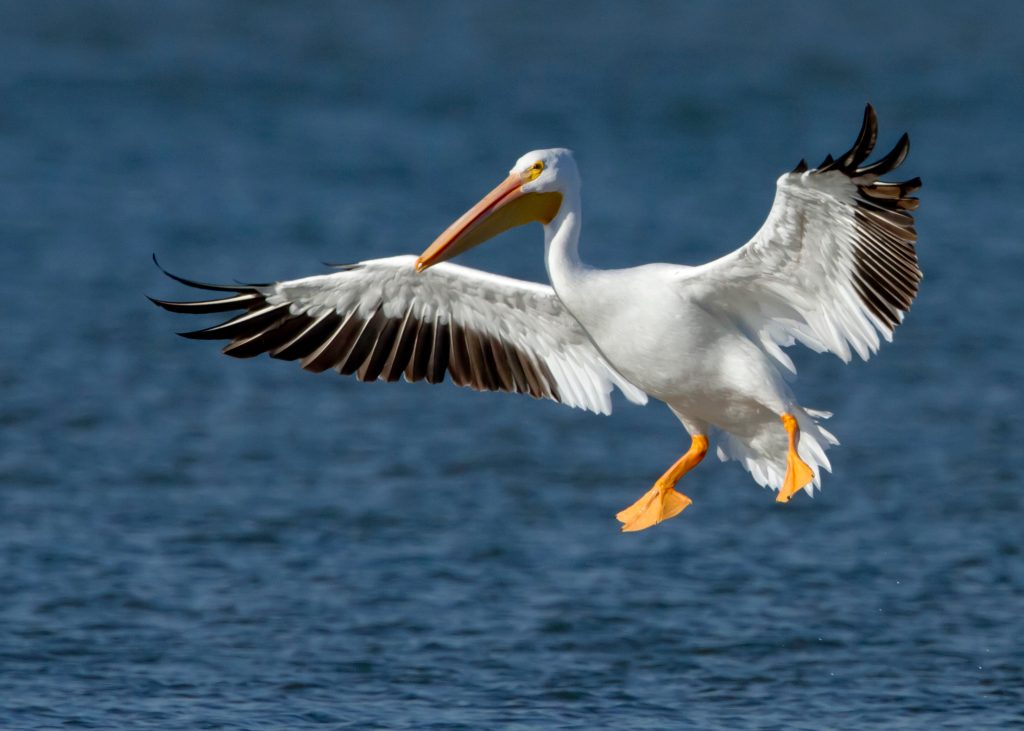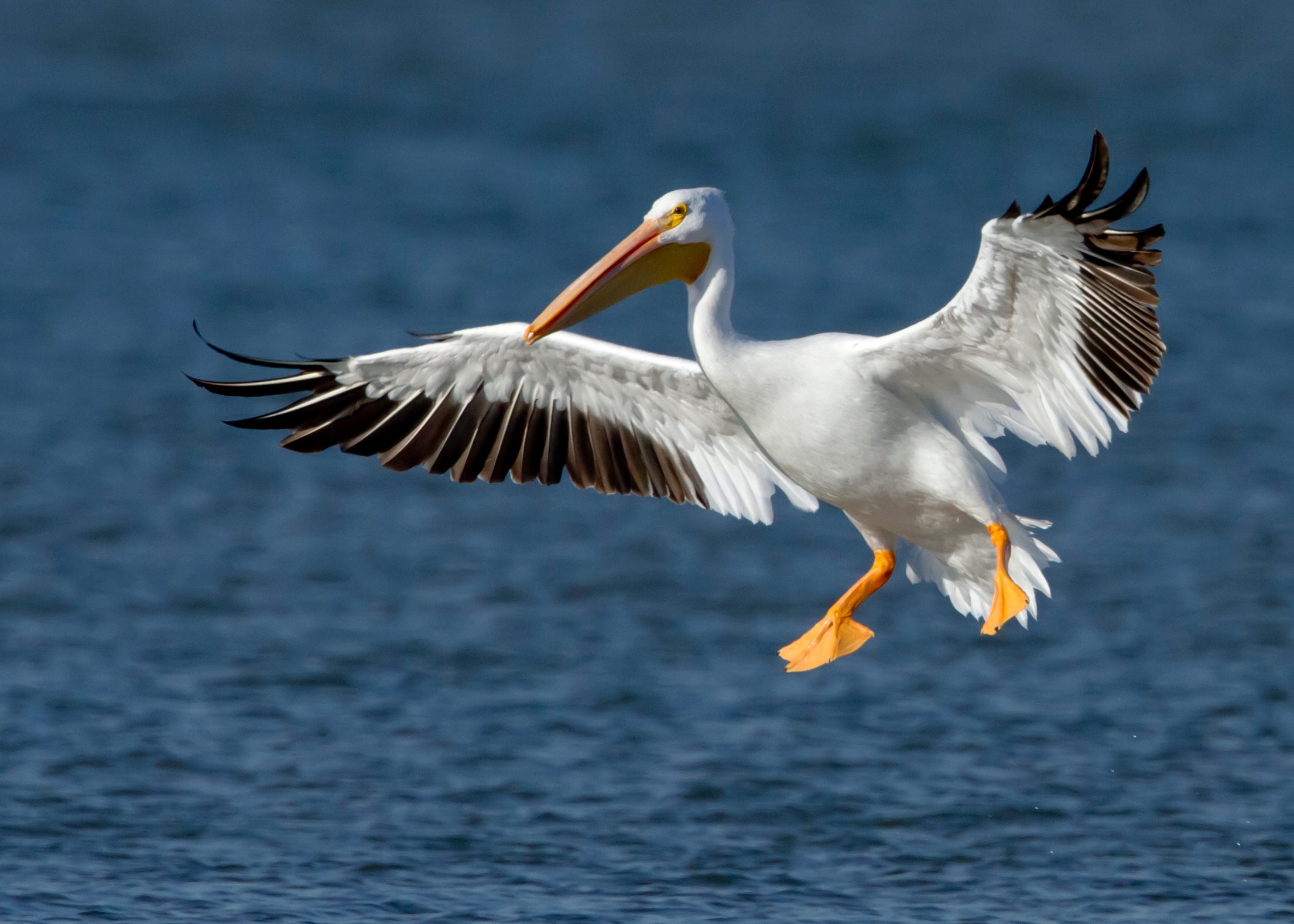In North America, you can discover two distinct varieties of Pelican, both of which can be observed in the state of Colorado. These avian creatures are the American White Pelican and the Brown Pelican.
During the summer months, one can easily spot the American White Pelican in Colorado. On the other hand, sightings of the Brown Pelican in this region are quite rare and infrequent.
Pelicans stand out among the avian population due to their remarkable characteristics such as their enormous bills, expandable throat pouches, and well-developed feet. Despite their large size, they possess a surprisingly light structure, thanks to air pockets within their skeleton and skin that enable them to float effortlessly. Additionally, their elongated wings facilitate graceful soaring during flight.
The world boasts a total of eight distinct species of pelicans, two of which inhabit North America. These two species are none other than the American White Pelican and the Brown Pelican.
During the breeding season, pelicans undergo striking transformations, as their facial skin, throats, and bills take on brighter hues, while some even develop additional structures on their bills.
Pelicans tend to breed in colonies comprising up to 50,000 individuals, and depending on the species, they may choose either ground or tree nesting sites. After approximately 25 days of nesting, the young ones gather in groups called “creches,” consisting of up to 100 fledglings. Astonishingly, the parents are capable of recognizing and solely feeding their own offspring.
Although pelicans are predators, they do not fall under the category of birds of prey, which is reserved for raptors. These remarkable birds predominantly consume fish, yet they also have a diverse diet that includes crabs, frogs, snakes, mammals, birds, and insects.
Their expandable throat pouch plays a crucial role in catching fish, allowing them to drain the water before swallowing their prey. Moreover, young pelicans are able to feed directly from their parents’ throat pouches.
To facilitate the identification of Pelican species spotted in Colorado, this guide utilizes information from the avibase database and data gathered by bird watchers on ebird. This reliable resource provides accurate details regarding the timing of these bird sightings.
Colorado is home to two distinct species of Pelicans
American White Pelican

American White Pelicans are present in Colorado throughout the year, but their population increases notably during the summer season. They are primarily observed in the central and northern regions of the state. Approximately 10% of the checklists submitted by bird watchers during the summer months include sightings of American White Pelicans.
These majestic birds possess expansive wingspans, ranking second only to the largest North American avian species.
Non-breeding adult American White Pelicans exhibit an entirely white plumage, with black flight feathers visible only during flight or when their wings are spread. They possess bluish-gray eyes and yellow facial skin surrounding their eyes. Their bills, pouches, and feet exhibit a pale orange hue. In contrast, juvenile American White Pelicans display light gray feathers with darker brown napes.
During the breeding season, adult American White Pelicans exhibit distinct changes in their coloring. They develop a yellow plate on their upper bills, resembling a horn. While their bodies remain completely white, their eyes, bills, legs, and feet acquire a brighter orange shade.
American White Pelicans undergo several molting changes, known as “eclipse.” In spring, a noticeable yellowish patch appears on their breasts and chests, while blackish feathers emerge on their heads during summer.
- Scientific Name: Pelecanus erythrorhynchos
- Length: 60 – 63 inches (152 – 160 cm)
- Weight: 246.4 ounces (6983 g)
- Wingspan: 96 – 110 inches (244 – 279 cm)
American White Pelicans breed in remote inland lakes across North America before migrating to the southern Pacific Coast of the United States, the Gulf of Mexico, Mexico, and Central America for the winter season. They can be sighted during their migratory journeys in various western and central U.S. states.
These magnificent birds prefer shallow freshwater lakes, wetlands, and the edges of lakes and rivers as their habitats. During winter, they can also be found in coastal bays, inlets, and estuaries, where they forage in shallow waters and rest on sandbars.
The primary diet of American White Pelicans consists of fish. They swim on the water’s surface, utilizing their enormous bills to capture prey. They also engage in cooperative foraging with other birds, employing strategic tactics to drive fish toward the shore, facilitating efficient feeding.
Moreover, American White Pelicans are opportunistic feeders, venturing far and wide in search of better feeding grounds. They occasionally consume crayfish, amphibians, salamanders, and have been observed stealing fish from other birds on the water’s surface.
When it comes to vocalization, American White Pelicans tend to be silent or emit only a few grunts. However, their young ones can become quite noisy within large colonies as they beg for food.
The nests of American White Pelicans are simple, shallow depressions on the ground. Twigs, sticks, reeds, and other materials are added atop the soil to offer protection for the eggs.
The female pelican then lays one to two eggs, which both parents diligently incubate for approximately thirty-six days. Unfortunately, due to siblicide, where one sibling kills the other, only one chick per nest typically survives.
Fun Fact: The long and massive bill of the American White Pelican possesses the incredible capacity to hold three gallons of water. When the bird scoops up fish from the sea, it tilts its bill downward to drain the water, allowing it to swallow the remaining fish within its throat sac.
Brown Pelican

The presence of Brown Pelicans in Colorado is considered rare or accidental, although they have been sporadically spotted, primarily around Denver, during the summer season.
Non-breeding adult Brown Pelicans typically exhibit white heads and necks, accompanied by pale yellow foreheads. Their long bills display a combination of yellow and orange hues. They possess grayish-brown bodies, short black legs, and webbed feet. Juveniles have brown heads, necks, backs, and wings, with bluish-gray bills and light brown underparts.
The Brown Pelican species consists of five subspecies, with two of them breeding in the United States. P.o.californicus represents the Pacific Coast variant, while P.o.carolinensis signifies the Atlantic Coast variant.
The most noticeable differences between the Pacific and Atlantic Brown Pelicans become apparent during the breeding season. Both species exhibit white heads with brighter yellow foreheads. However, their napes display a transition from white to dark brown. Atlantic Brown Pelicans possess olive-brown throat pouches, while Pacific Brown Pelicans exhibit red skin in their throat pouch area.
- Scientific Name: Pelecanus occidentalis
- Length: 48 – 50 inches (122 – 127 cm)
- Weight: 131.2 ounces (3718 g)
- Wingspan: 78 – 84 inches (198 – 213 cm)
Brown Pelicans either breed and migrate or remain residents throughout the year along the Pacific and Atlantic Coasts of North America, extending to northern South America.
These remarkable birds prefer habitats characterized by shallow water environments. They reside year-round in estuaries and coastal marine areas. Additionally, they can be observed in mangrove islets, as well as on sandbars, breakwaters, and offshore rocks, where they rest.
Brown Pelicans possess a unique foraging ability that sets them apart. They are capable of diving into deep ocean waters to capture prey within their throat pouches. Upon resurfacing, the water drains from their pouches, allowing them to immediately consume their catch.
Their primary diet consists of fish, such as sardines and herring. When not engaged in diving, Brown Pelicans casually swim and seize prey using their bills. They may also consume crustaceans like prawns, amphibians, eggs, and young birds.
When it comes to vocalization, adult Brown Pelicans tend to be silent, except for occasional grunts. Juveniles, however, vocalize loudly to beg for food.
Unlike American White Pelicans, Brown Pelicans more commonly build nests on the ground rather than in trees. These nests are typically concealed and protected on islands, mangroves, and cliffs. The female constructs the nest using reeds, leaves, pebbles, sticks, and soil. Each clutch typically consists of two to four eggs, which are incubated by both parents for approximately a month.
Fun Fact: Brown Pelicans incubate their eggs by covering them with their webbed feet. Unfortunately, the usage of this practice had detrimental effects on the species in the past, as the pesticide DDT caused thinning of the eggshells, leading to their breakage under the weight of the parent’s feet. Multiple conservation efforts were required to restore the population of Brown Pelicans.
